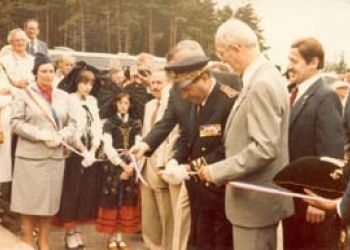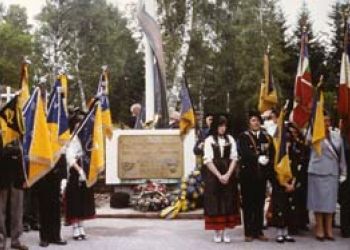The Association and the story
of Mémorial du Linge
The Musée du Linge was inaugurated in June 1981, on the initiative of a handful of history buffs and veterans who wished to preserve the memory of the Battle of the Linge. The idea of creating a museum dedicated to this event was born of this desire to pay tribute to the soldiers who fought on these lands, and to pass on to future generations the memory of this tragic period in history.
Thanks to the mobilization of association members, volunteers and local authorities, the project was able to come to fruition.
Individuals, families, veterans and history buffs have generously contributed objects, photographs, documents and testimonials relating to the Battle of the Linge.
The association today
The LINGE Memorial is run entirely by a local association of around 70 volunteer members, who welcome visitors, maintain the museum and the battlefield, run guided tours and manage the collections. The preserved battlefield site is listed as a Monument Historique and belongs to the French State, while the museum walls belong to the commune of Orbey, which has entrusted their management to the association.
The committee currently comprises the following members:
- General (2S) Dominique MULLER: Chairman
- José BRETZ: Vice-Chairman
- Rose Blanche DUPONT: Treasurer
- Thierry GARAND: Assistant Treasurer
- Régine HENRY: Secretary
- Blandine JACQUEY; Assistant Secretary
- Antoine BALTHAZARD : Assessor
- Michel COMPOINT: Assessor
- Bruno FERRY : Assessor
- Andréa IRTANUCCI : Assessor
- Bertrand MUNIER: Assessor
- Daniel SAVOYEN : Assessor
Although the museum is closed from November to Easter due to winter conditions and the closure of the access road, the association's activities continue throughout the year.
Specialized teams have been set up for day-to-day management in the following areas:
- Visitors' museum reception
- Guides
- Interior and exterior maintenance work
- Museography
- Bookshop and store management
- Communication
The association is always on the lookout for volunteers wishing to get involved in the operation and continuity of the Mémorial du LINGE.
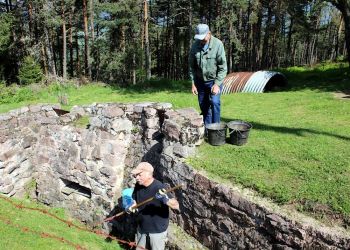
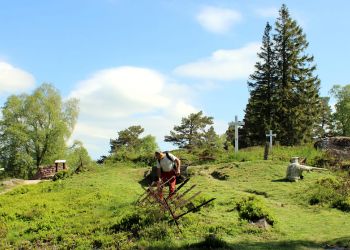
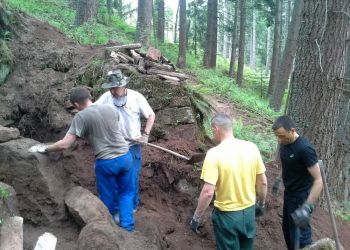
The early history of the Memorial
It's the height of summer in 1967. Mr. Armand Durlewanger, out walking at the Collet du Linge, meets a 1915 veteran accompanied by his grandsons. With tears in his eyes, the latter deplored the fact that this high spot, where so many of his comrades had fallen during the terrible fighting of 1915, had been transformed into a garbage dump and left to lie fallow. The Linge, which had been classified as a "historic monument" in 1921, was "more abandoned than the most crumbling feudal ruins in the Vosges".
The following year, marking the fiftieth anniversary of 1918, Mr. Armand Durlewanger resolved to restore the Linge to its former glory as a witness to an historic tragedy, and to make it a memorial to the suffering shared by the men of two peoples once at war, then "reconciled over the graves". In the spring of 1968, the first team of clearers and diggers launched the battlefield renovation operation known as "Operation Remembrance".
The team was largely made up of young people from the Europe Youth Hostel in Colmar. During the clearing work carried out by this team of volunteers, which focused on clearing and repairing the 1st and 2nd German lines, several skeletons of French soldiers were exhumed. These are now marked with white crosses.

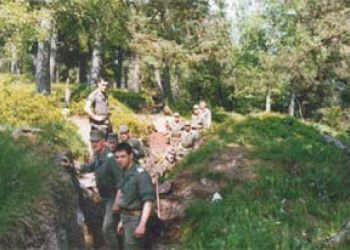
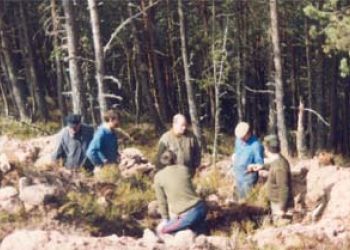

Creation of an initial committee
With the first works due for completion in the autumn, a first committee was set up on October 3, 1968, to decide on the future construction of a memorial to house a Musée du Souvenir de la Guerre des Vosges 1914-1918. A national subscription campaign was launched for the construction of the memorial, scheduled for 1970. The committee, which drew up the new association's articles of association, comprised :
- Mr Jean d'ARMAU DE POUYDRAGUIN, son of the General - Paris
- M. WETZEL, Cabinet Director, Haut-Rhin Prefecture - Colmar
- M. KUBLER, Mayor of Sélestat
- M. HEMMERLE, Director of Dernières Nouvelles d'Alsace - Colmar
- Dr. GRUNENWALD, President of the Colmar Reserve Officers' Association
- M. VOGELEISEN, retired from the Education Nationale - Munster
- M. WISSON, SNCF agent - Wihr au Val
- M. SCHUSTER, Mayor of Orbey
- M. RAFFNER, President of Souvenir Français - Orbey
- M. DURLEWANGER, historian - Colmar
- M. FLECKINGER, paint company manager - Colmar
- M. GRAFF, retired - Munster
- M. HERZ, Architecte des Bâtiments de France - Colmar
- Mr DUPUY, retired non-commissioned officer - Colmar
- Mr HELSTROFFER, Director, Colmar Youth Hostel
- M. SCHARFF, photographer - Colmar
- M. OBERLIN, Interdepartmental Director, ONAC - Strasbourg
Birth of the association
The following year, on April 15, 1969, the Constitutive General Meeting baptized the new "Association du Mémorial du Linge ". Its aims were to bring together people of good will, efforts and resources to ensure the preservation of the Linge battlefield and the protection of its natural site.
Restoring the battlefield
This year, the committee is planning to clear the ridge and the French lines below the German lines. In addition to special competitions, a small core of volunteers is involved in the various activities required to restore the battlefield: Mr and Mrs BOSSHARTH, Messrs WEISS, DUPUY, WISSON, FLECKINGER, GEORGE.
That year, the 9th Engineer Regiment from Neuf-Brisach helped out:
- one section clears the ridge of undergrowth and trees to make it accessible to visitors.
- another team carries out the difficult installation of a large 20-meter mast.
Since May 24, the three colors have been flying at this high spot at an altitude of 1,000 meters. The 30th Groupe de Chasseurs from Lunéville and the 152nd Infantry Regiment from Colmar are also helping to restore the site.
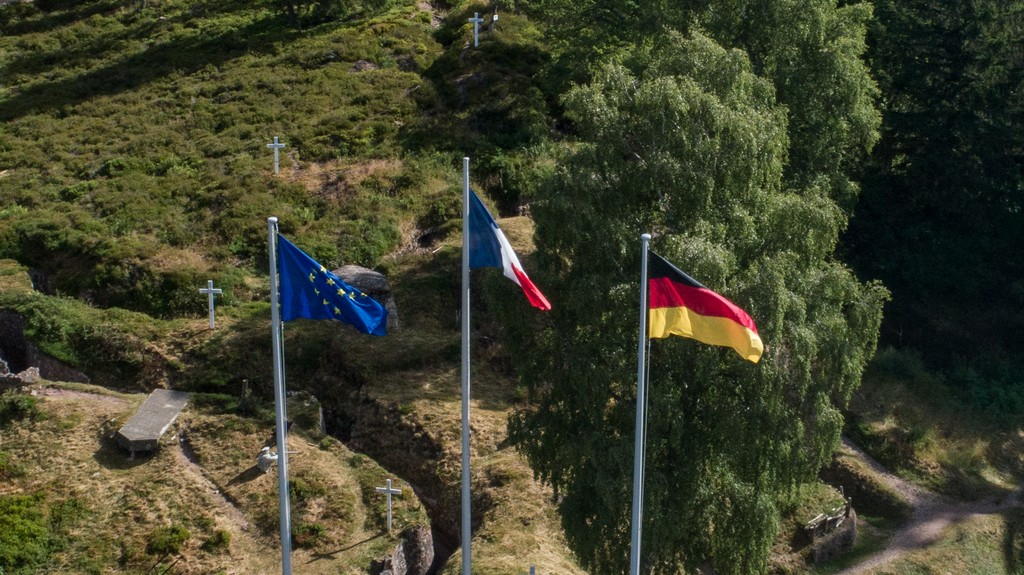
In June, the Service de l'Équipement du Haut-Rhin laid asphalt on the esplanade and installed "historic sites and monuments" signs at the main crossroads serving the Linge.
In August, the Service des Monuments Historiques began work on consolidating the German 1st line. This season saw the exhumation of twenty new French soldiers (including 3 identified), to add to the ten chasseurs (including 1 identified) exhumed in 1968. At the same time, five German soldiers were exhumed.
Start of work
The Secretaries of State for Cultural Affairs and Veterans Affairs agree to sponsor the committee in its work of "Remembrance". The presentation of the model (designed by M. Chomel) for the Memorial was held at the Colmar Chamber of Commerce. In 1975, thanks to the intervention of Prefect Burgalat, the building permit for the Memorial Museum was finally granted by the Secretary of State for Culture. A 50-strong platoon from the 30th Groupe de Chasseurs de Lunéville undertook the first earthworks for the Memorial in August. In September, the remains of a young hunter from the class of 1915 (121st BCP), unearthed in July, were buried in the Wettstein cemetery.
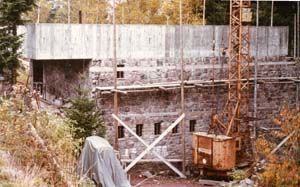
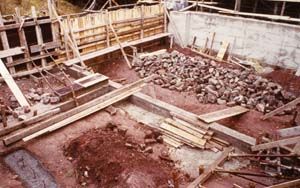
First public tours of the battlefield
In 1977, under the impetus of M. Marcel Maire, Orbey veterans Messrs Demangeat, Kohler, Perrin, Pierré, Werlé and Marchand were on hand every Thursday and Friday at the entrance to the battlefield to help build the Memorial. In June 1980, just a few months before the Memorial was to be completed, the barracks adjoining the battlefield burned down, along with many relics found on the battlefield and part of the library (books and postcards). All that remains of the hut are ashes. The most important loss is undoubtedly the "Golden Book". In addition, the flag on the main flagpole has disappeared. The Gendarmerie is investigating...

The Memorial Museum
The Memorial was inaugurated on August 9, 1981, the second Sunday in August traditionally seeing commemorative ceremonies at the Wettstein and Baerenstall cemeteries. It comprises the central part of today's building, with 3 exhibition levels and a reception area. Visitor numbers were high from the outset, with over 50,000 visitors a year for a 7-month opening period. Groups and schoolchildren are numerous, while the battlefield continues to be refurbished and made safe. Volunteers and the committee soon realized that the museum was becoming too cramped to accommodate such an influx of visitors. The decision was taken to extend the museum, adding a projection room on the ground floor, a new exhibition area and toilets in the basement. A documentary in 3 languages was produced to provide a historical background to the Battle of the Linen. The extension was opened to the public in 1995.
With the centenary of the Great War approaching, a new extension was decided upon, facilitated by the introduction of public funding specifically for this event. The left wing of the current building, with 2 exhibition levels including a reconstructed German trench, was inaugurated in 2015, the year of the centenary of the Battle of the Linen. Since then, the site has been very popular, with around 40,000 visitors a year, plus free tours of the battlefield when the museum is closed. A new extension is planned for 2024 to improve the reception area and bookshop.

